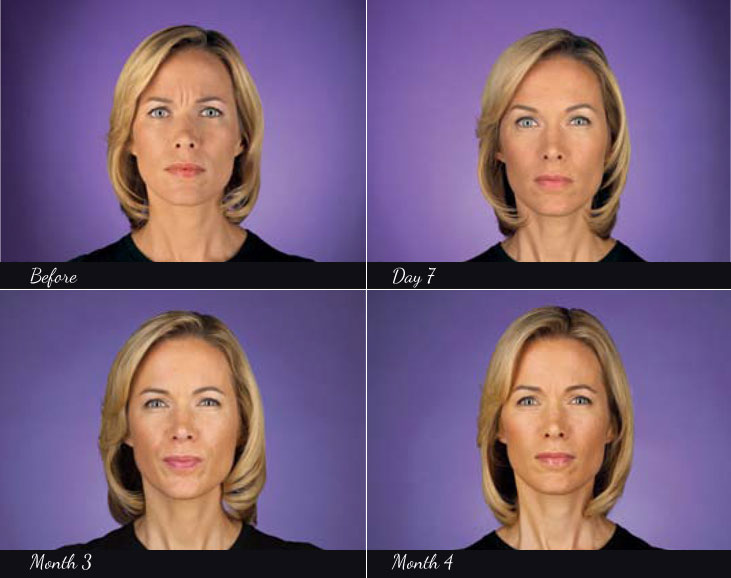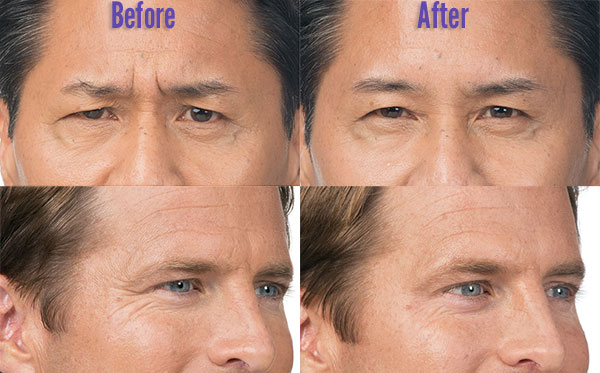Want to look youthful?

Unretouched photos of paid model taken at maximum frown after treatment with BOTOX® Cosmetic (onabotulinumtoxinA) at month 3 and month 4. Individual results may vary.
In clinical trials at day 90, 48% of patients demonstrated none or mild glabellar line severity at maximum frown as
compared to 2% in placebo; at day 120, 25% of patients demonstrated the same as compared to 2% in placebo.1

Top photos: Photos taken at maximum frown before and after treatment with BOTOX® Cosmetic (onabotulinumtoxinA) at day 7. In clinical studies, physicians assessed 80% of people had significant improvement at day 30.
Bottom photos: Photos taken at full smile before and after treatment with BOTOX® Cosmetic (onabotulinumtoxinA) at day 7. In two clinical studies, 26.1% and 20.3% of people had ≥ 2-grade improvement at day 30. In one of these studies, 67.9% of people had mild or no crow’s feet at day 30 after treatment.
Side effects associated with the injection include localized pain, infection, inflammation, tenderness, swelling, redness, and/or bleeding/bruising.
* BOTOX® Cosmetic (onabotulinumtoxinA) Important Information
Indication
BOTOX® Cosmetic is a prescription medicine that is injected into muscles and used to improve the look of moderate to severe frown lines between the eyebrows (glabellar lines) in people 18 to 65 years of age for a short period of time (temporary).
IMPORTANT SAFETY INFORMATION
BOTOX® Cosmetic may cause serious side effects that can be life threatening. Call your doctor or get medical help right away if you have any of these problems any time (hours to weeks) after injection of BOTOX® Cosmetic:
- Problems swallowing, speaking, or breathing, due to weakening of associated muscles, can be severe and result in loss of life. You are at the highest risk if these problems are pre-existing before injection. Swallowing problems may last for several months
- Spread of toxin effects. The effect of botulinum toxin may affect areas away from the injection site and cause serious symptoms including: loss of strength and all-over muscle weakness, double vision, blurred vision and drooping eyelids, hoarseness or change or loss of voice (dysphonia), trouble saying words clearly (dysarthria), loss of bladder control, trouble breathing, trouble swallowing. If this happens, do not drive a car, operate machinery, or do other dangerous activities
The dose of BOTOX® Cosmetic is not the same as, or comparable to, another botulinum toxin product.
There has not been a confirmed serious case of spread of toxin effect when BOTOX® Cosmetic has been used at the recommended dose to treat frown lines.
Serious and/or immediate allergic reactions have been reported. They include: itching, rash, red itchy welts, wheezing, asthma symptoms, or dizziness or feeling faint. Tell your doctor or get medical help right away if you are wheezing or have asthma symptoms, or if you become dizzy or faint.
Do not take BOTOX® Cosmetic if you: are allergic to any of the ingredients in BOTOX® Cosmetic (see Medication Guide for ingredients); had an allergic reaction to any other botulinum toxin product such asMyobloc® (rimabotulinumtoxinB),Dysport® (abobotulinumtoxinA), or Xeomin® (incobotulinumtoxinA); have a skin infection at the planned injection site.
Tell your doctor about all your muscle or nerve conditions, such as amyotrophic lateral sclerosis (ALS or Lou Gehrig's disease), myasthenia gravis, or Lambert-Eaton syndrome, as you may be at increased risk of serious side effects including severe dysphagia (difficulty swallowing) and respiratory compromise (difficulty breathing) from typical doses of BOTOX® Cosmetic.
Tell your doctor about all your medical conditions, including: plans to have surgery; had surgery on your face; weakness of forehead muscles, such as trouble raising your eyebrows; drooping eyelids; any other abnormal facial change; are pregnant or plan to become pregnant (it is not known if BOTOX® Cosmetic can harm your unborn baby); are breast-feeding or plan to breast-feed (it is not known if BOTOX® Cosmetic passes into breast milk).
Human albumin and spread of viral diseases. BOTOX® Cosmetic contains albumin, a protein component of human blood. The potential risk of spreading viral diseases [eg Creutzfeldt-Jakob Disease (CJD)] via human serum albumin is extremely rare. No cases of viral diseases or CJD have ever been reported in association with human serum albumin.
Tell your doctor about all the medicines you take, including prescription and nonprescription medicines, vitamins, and herbal products. Using BOTOX® Cosmetic with certain other medicines may cause serious side effects. Do not start any new medicines until you have told your doctor that you have received BOTOX® Cosmetic in the past.
Especially tell your doctor if you: have received any other botulinum toxin product in the last 4 months; have received injections of botulinum toxin, such as Myobloc®, Dysport®, or Xeomin® in the past (be sure your doctor knows exactly which product you received); have recently received an antibiotic by injection; take muscle relaxants; take an allergy or cold medicine; or take a sleep medicine.
Other side effects of BOTOX® Cosmetic include: dry mouth, discomfort or pain at the injection site, tiredness, headache, neck pain, and eye problems: double vision, blurred vision, decreased eyesight, drooping eyelids, swelling of your eyelids, and dry eyes.
For more information refer to the Medication Guide or talk with your doctor.
You are encouraged to report negative side effects of prescription drugs to the FDA. Visit www.fda.gov/medwatch or call 1-800-FDA-1088.
Please see BOTOX® Cosmetic full Product Information including Boxed Warning and Medication Guide.
